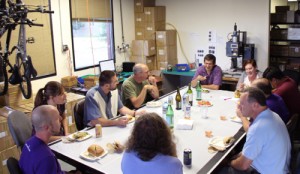 Continue reading
Continue reading  Continue reading
Continue reading This is an archived site.
Please visit the Modular Robotics current site for up to date prices and information.

 Continue reading
Continue reading  Like most sixteen-year-olds, Hayley Brady’s interests cover the map. An avid painter, she is also involved in various activities at her school, most notably as the vice president of the “nerd club.”
“[It’s] basically a place for people who are interested in science, movies, comic books, TV shows, and video games to come and discuss and occasionally debate about their interests.”
The Dublin, Ireland native has the same big dreams as most 16-year-olds, too, wanting to study veterinary medicine. She already volunteers with a local animal rescue group, helping trap and neuter feral cats, or fostering animals in need.
But Hayley isn’t just focused on her future: she has already made a huge contribution to her local school, and qualified for the BT Young Scientist and Technology Exhibition Final in January of 2018.
How? Hayley recognized the potential of Cubelets robot blocks as a tactile and interactive way to reach students with Autistic Spectrum Disorder. Her project, “The Development of An Interactive and Tactile Learning Programme for Children With Autism Spectrum Disorder Using Modular Robotics.” was deemed “inspiring” by the BTYSTE judges, and was seen by over 50,000 people at the exhibition.
Continue reading
Like most sixteen-year-olds, Hayley Brady’s interests cover the map. An avid painter, she is also involved in various activities at her school, most notably as the vice president of the “nerd club.”
“[It’s] basically a place for people who are interested in science, movies, comic books, TV shows, and video games to come and discuss and occasionally debate about their interests.”
The Dublin, Ireland native has the same big dreams as most 16-year-olds, too, wanting to study veterinary medicine. She already volunteers with a local animal rescue group, helping trap and neuter feral cats, or fostering animals in need.
But Hayley isn’t just focused on her future: she has already made a huge contribution to her local school, and qualified for the BT Young Scientist and Technology Exhibition Final in January of 2018.
How? Hayley recognized the potential of Cubelets robot blocks as a tactile and interactive way to reach students with Autistic Spectrum Disorder. Her project, “The Development of An Interactive and Tactile Learning Programme for Children With Autism Spectrum Disorder Using Modular Robotics.” was deemed “inspiring” by the BTYSTE judges, and was seen by over 50,000 people at the exhibition.
Continue reading  I’m writing this post from Atlanta, a land of endless fried vegetables and phenomenally good jazz and brass band music. We’re here for the ISTE 2014 conference. We’ve met some inspiring educators and innovators here, and it’s been great to have our booth on the Exhibition floor as well as have the team giving four presentations during the conference. We’re so excited to have so many chances to connect with educators, give them a chance to try Cubelets and MOSS, and share ideas.
After this I head to Dallas where I’ll be co-managing a really cool and out-of the-box collaboration between our company and the Frontiers of Flight museum. This is big, everyone – while MOSS has been out in the world, this is the first time we’ll be using it for structured education and I’m thrilled to pilot it in a new camp that we are jointly offering with this museum on engineering, robotics, and space! As a bonus, while I’m in Dallas, I’m doing a Radio Disney interview about robots, education, and what we’re doing. I also get to work with with Perot Museum of Nature and Science’s Leaders in Science Teachers, and their Family Discovery day on July 12th.
Then I jet off to Chicago where colleague Donald Ness and I will be talking about how playing with robots can lead to computational thinking and learning about code at CSTA’s 2014 conference.
Once I’m back, I’m slated to be at RAFT Colorado’s Summer Symposium for teacher training, and then doing a full-day teacher STEM experience with robots at Xsci.
It’s a full dance card for Mod Bot Edu, but we’re thrilled to have the opportunity to share our results and work directly with a wider group of awesome and inquisitive educators. We have our eye on a few new places to be and be seen in 2015 so don’t be surprised if you see us hitting the road again then!
I’m writing this post from Atlanta, a land of endless fried vegetables and phenomenally good jazz and brass band music. We’re here for the ISTE 2014 conference. We’ve met some inspiring educators and innovators here, and it’s been great to have our booth on the Exhibition floor as well as have the team giving four presentations during the conference. We’re so excited to have so many chances to connect with educators, give them a chance to try Cubelets and MOSS, and share ideas.
After this I head to Dallas where I’ll be co-managing a really cool and out-of the-box collaboration between our company and the Frontiers of Flight museum. This is big, everyone – while MOSS has been out in the world, this is the first time we’ll be using it for structured education and I’m thrilled to pilot it in a new camp that we are jointly offering with this museum on engineering, robotics, and space! As a bonus, while I’m in Dallas, I’m doing a Radio Disney interview about robots, education, and what we’re doing. I also get to work with with Perot Museum of Nature and Science’s Leaders in Science Teachers, and their Family Discovery day on July 12th.
Then I jet off to Chicago where colleague Donald Ness and I will be talking about how playing with robots can lead to computational thinking and learning about code at CSTA’s 2014 conference.
Once I’m back, I’m slated to be at RAFT Colorado’s Summer Symposium for teacher training, and then doing a full-day teacher STEM experience with robots at Xsci.
It’s a full dance card for Mod Bot Edu, but we’re thrilled to have the opportunity to share our results and work directly with a wider group of awesome and inquisitive educators. We have our eye on a few new places to be and be seen in 2015 so don’t be surprised if you see us hitting the road again then!
 Furniture has been built and crated for shipping.
Furniture has been built and crated for shipping.

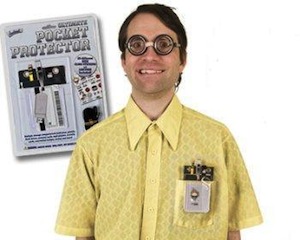 And, don’t get me wrong, we did have quite a thing about graph paper, mechanical pencils, and protractors in my house growing up (most memorably, when designing Jack-o’-lantern faces in October). But my strongest memories of absorbing engineering by osmosis have a lot more to do with being asked to make a deliberate practice of defining a challenge and naming possible solutions – in my homework, in the kitchen, and in how we did chores and laundry and leaf-raking.
I’ve read scary statistics about workforce readiness and the state of our education to prepare students to be innovators, problem solvers, and engineers. things like, At the current growth rate of engineering jobs we will produce only one-third of the engineer educated students we need to fill those jobs in 10 years. I’m not sure how to verify the accuracy of these numbers, and of course, they depend on a lot of multi-variate and ever-changing factors.
I suspect the point of these statements is to get us all thinking about what we can do differently for our children and students and schools. So, on that criteria, this statement works for me. I thought about how privileged I was to grow up with engineering in my life, and indeed, my home. I also realized how awesome it is to work here surrounded by engineers and to be reintroduced to the language and unique problem solving processes engineers use. (It’s not uncommon to hear our staff saying “Can we pursue a solution that gets around that constraint? or “How can we reverse engineer that?” about non-engineering challenges.)
And I went away and, with the help of a four amazing collaborators from Science Matters, wrote the first installment of an Engineering and Design Principles unit! Students can learn valuable engineering approaches from making robots, and while we’ll add more lesson plans to this unit in the future, I wanted to get it out there now and see what teachers, camps, and clubs thought if it. Enjoy this collection of 5 lesson plans (soon to be more!) individually, or as a progression and unit of learning to introduce engineering as a cool way of approaching science and design together with your students – and be sure to let us know what you think!
And, don’t get me wrong, we did have quite a thing about graph paper, mechanical pencils, and protractors in my house growing up (most memorably, when designing Jack-o’-lantern faces in October). But my strongest memories of absorbing engineering by osmosis have a lot more to do with being asked to make a deliberate practice of defining a challenge and naming possible solutions – in my homework, in the kitchen, and in how we did chores and laundry and leaf-raking.
I’ve read scary statistics about workforce readiness and the state of our education to prepare students to be innovators, problem solvers, and engineers. things like, At the current growth rate of engineering jobs we will produce only one-third of the engineer educated students we need to fill those jobs in 10 years. I’m not sure how to verify the accuracy of these numbers, and of course, they depend on a lot of multi-variate and ever-changing factors.
I suspect the point of these statements is to get us all thinking about what we can do differently for our children and students and schools. So, on that criteria, this statement works for me. I thought about how privileged I was to grow up with engineering in my life, and indeed, my home. I also realized how awesome it is to work here surrounded by engineers and to be reintroduced to the language and unique problem solving processes engineers use. (It’s not uncommon to hear our staff saying “Can we pursue a solution that gets around that constraint? or “How can we reverse engineer that?” about non-engineering challenges.)
And I went away and, with the help of a four amazing collaborators from Science Matters, wrote the first installment of an Engineering and Design Principles unit! Students can learn valuable engineering approaches from making robots, and while we’ll add more lesson plans to this unit in the future, I wanted to get it out there now and see what teachers, camps, and clubs thought if it. Enjoy this collection of 5 lesson plans (soon to be more!) individually, or as a progression and unit of learning to introduce engineering as a cool way of approaching science and design together with your students – and be sure to let us know what you think!
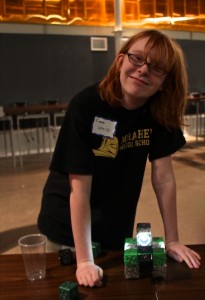
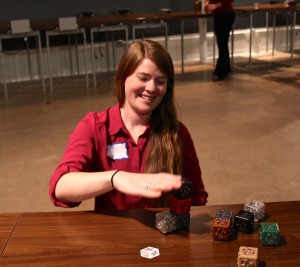 Kelly’s smart-driver
Kelly’s smart-driver
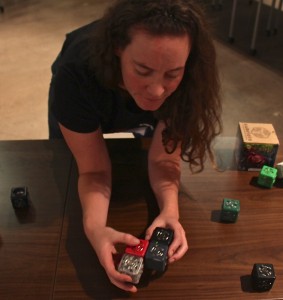 Helen made fast friends with us at our table, playing and making lots of robots
So we were thrilled when she won the raffle and went home with a KT06 of her own!
Helen made fast friends with us at our table, playing and making lots of robots
So we were thrilled when she won the raffle and went home with a KT06 of her own!
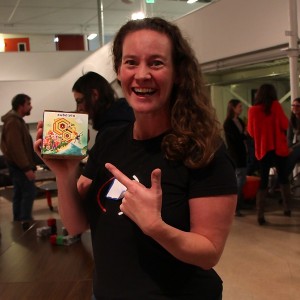 Thanks for having us Girl Geek – we loved talking about how Cubelets are a robot construction kit for everyone. We loved having smart ladies of all ages build amazing robots with us even more!
Thanks for having us Girl Geek – we loved talking about how Cubelets are a robot construction kit for everyone. We loved having smart ladies of all ages build amazing robots with us even more! Recently, I worked with a really cool and diverse group of teachers and librarians at Colorado RAFT Teacher Symposium. When I was approached to do this and heard it was a three hour workshop, I was unconditionally thrilled. A whole morning with creative teachers who are invested in hands-on education (why else would they be involved with RAFT?) and Cubelets? Pick me.
Others expressed doubts – what will you do with them for three hours? Won’t you get tired? Won’t they get bored? I’ve been doing fast-and-snappy teacher professional development workshops since April and had some practice laps in, so I felt ready. For me, the key is paying attention to what teachers want, what they need, and determining where we can fit in. After my first time offering teachers a chance to play with Cubelets, I remember being psyched with how little time it took adults to stoop down on their hands and knees in order to build driving, racing robots. I have a background in training instructors, so I wasn’t nervous to train a room of teachers; but I was pleased to witness that the level of active curiosity I see with kids and Cubelets bubbles up in adults too.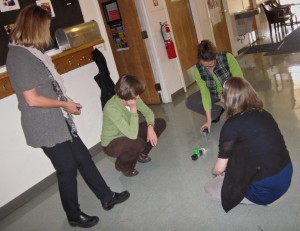
Offering more teacher professional development workshops wasn’t only good practice for me, it meant I learned more specifics about what teachers want. I heard teachers commenting that educators need to talk about STEAM, not just STEM. (The ‘A’ is for Arts. And after all, engineers design and make. And that does lead right back to the arts.) I listened well when teachers said they needed clever ways to teach cause and effect. I paid attention when teachers mentioned how popular robotics was in STEM right now, and how hard it is to find an options that will “start kids off” before engaging with robotics kits that require programming.
Most memorably, on my third try at teacher professional development, I heard some teachers who had not been in my workshop gabbing in the hall. They didn’t know I was behind them and said, “The last thing I want as a teacher is someone who hasn’t had to do it in the classroom trying to tell me how something will go with my students as a way of hard selling me.” YUP! Iloathe the “hard sell” approach. I’d hate it even more if someone tried to tell me what would and wouldn’t work in my classrooms without having any experience with any students, much less my students. For this reason that I do my best to test each and every lesson plan idea I have on real students. I do this not because I want to have a more convincing sell to teachers, but rather, because I want our lesson plans to impart real, use-in-your-classes value when teachers, camps, and schools do buy Cubelets. Bonus: this frees me up to do what works anyways – let the Cubelets do the talking! I jabber for just a few minutes and then focus on listening to good educator ideas and facilitating teachers to play and learn. In short, I’m back to seeing how fast I can get teachers playing, letting their inner-child bring out their creativity and mixing it with their expertise about what their students, classrooms, and schools need.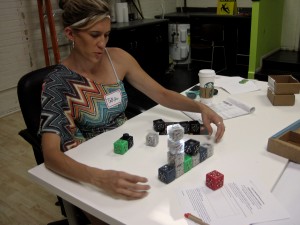
I often find that people (of all ages) gain deeper comprehension of “what do they do” once they have their hands on Cubelets, than if I stand, demo, and talk about them. It’s not that questions don’t come up. Of course they do! But answering them is far easier and more enjoyable when people can try things out live. Teachers especially want to see things in action.
For this three hour session I saw teachers on their hands and knees playing with their robots. I saw art teachers making robots, and then hastily and creatively constructing environments for their robots. I saw teams of educators making robots that react to other robots and dubbing it, “the robot dance party. “ I had teachers joke that they were using the “force” (Distance Cubelet) to control driving robots and comment on how kids could see this as magic, but then investigate what was causing that “magic.” More substantially I heard teachers ask (and answered): “I want something for teens and tweens to do that will inspire them to use technology for more than texting and Youtube.” We’re really interested in students gaining intuitions about systems, logic, and computational thinking in tangible, immediate ways that give them feedback so that they can more confidently take on wanting to engineer, design, or write code in abstract ways.“I want my art students to think about design like this.”
We love seeing students (and teachers!) design by pulling things apart and re-configuring them so fast they almost don’t have time to articulate their plan! “Can I ask you more about emergent behavior? When I hear “behavior” I think of the students’ behaviors in class but as I’m making this robot, I think you mean something different.” This was one of my favorite questions to answer! “Because each Cubelet has exactly one function people often think the way to track ‘how many’ they can make has to do just with the counting (or combinatorics) of each Cube, function, or the faces on the Cubelets. But sometimes as you’re adding functions and the Cubelets are sending and receiving information from more than one other Cubelet, behaviors emerge that you didn’t plan or design. It’s what makes people refer to Cubelets robots as animals or people-like even though they are the least android-looking robots I’ve ever seen.” “These robots are different from other robots, aren’t they? There’s no brain pieces – they are all sharing data.” Yes! Cubelets robots are a distributed system. That sounds technical. Another way to say it is that every component is parallel and “talks” directly to one another. Imagine if your foot was connected directly to your ears, with no brain mediating sensory information or reactions.“What’s the youngest you’ve seen students ‘get it’ with these?”
I’ve seen a child who wasn’t yet 3 years old build sense-act robots successfully and ask me enough questions to use ALL of the senses and actions!“What’s the oldest you’ve seen students still stay motivated and engaged with Cubelets?”
We know that the shape and colors of Cubelets gives them the gross-motor, young child, Pre-K look. Pre-schoolers can “get it” with minimal support and the right set-up. But as older students get their hands on Cubelets, they too get it, and add layers of sophistication, posing their own questions and challenges, and then setting themselves up to construct the right investigation to answer themselves. Quite simply, I’ve been amazed with what students do with Cubelets from ages not-yet-three up to 18!
“Do you think this could be used for Special Ed science?” Yes! Since I’ve seen kids from Pre-K all the way up to 12th grade work with Cubelets in developmentally appropriate ways, I could easily find the point on that continuum that your Special Ed student(s) matched up with and make adjustments that would make a Cubelets Lesson plan work!But mostly what I heard was “Come look at what I made!”
Not that different from what happens when I pack up Cubelets and take them into schools and camps full of kidos! Lots of excitement and discovery – not surprising. After all, all the best educators I know work with students because they found ways to learn enjoyably and wanted to pass it on. Of course these same people know how to locate their inner-excited-student!
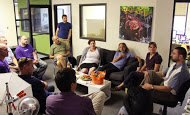 We’re lucky to know so many quality Modular Robotics enthusiasts that we could draw together educators representing a lot of variety – Pre-K to high school, from arts and electronics to engineering and robotics, and from public school teacher to retired software engineer/new after school program leader to our friends at SparkFun. Smart, imaginative, and every single one fired up by the idea of how to share ideas and raise hands-on education above the level of playtime.
This kind of talk sounds lofty and high-horsed. I know I have particular ideas about what people should learn and how that can be achieved. I also know I’m not alone. What was special about this gathering was not that it was a crowd of followers, but rather a community of people who each have particular ideas, but care more about sharing those ideas in powerful ways than beating down other perspectives.
Food and fun help bring these kinds of groups together in a positive way, of course, so as hosts we did our part to treat our guests to entertaining education and yummies.
We’re lucky to know so many quality Modular Robotics enthusiasts that we could draw together educators representing a lot of variety – Pre-K to high school, from arts and electronics to engineering and robotics, and from public school teacher to retired software engineer/new after school program leader to our friends at SparkFun. Smart, imaginative, and every single one fired up by the idea of how to share ideas and raise hands-on education above the level of playtime.
This kind of talk sounds lofty and high-horsed. I know I have particular ideas about what people should learn and how that can be achieved. I also know I’m not alone. What was special about this gathering was not that it was a crowd of followers, but rather a community of people who each have particular ideas, but care more about sharing those ideas in powerful ways than beating down other perspectives.
Food and fun help bring these kinds of groups together in a positive way, of course, so as hosts we did our part to treat our guests to entertaining education and yummies.
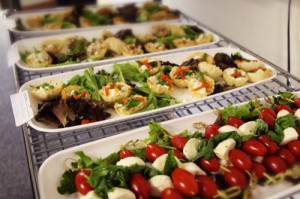 I’ve been working with a number of science programs that have schooled me in the language of claims and evidence so let me tell this next part of the story in that STEM-speak.
Claim: Even if our dinner menu had been less stellar, the company we gathered would still have collaborated on creative ideas that blew me away.
Evidence: In the “Cubelets Dinner Party Challenge” part of the evening they created chicken and cow robots! Starting with a simple robot (no more than 5-6 Cubelets) they tinkered and came up with robots representing farm animals. Never in my wildest imagination would I have predicted that!
I’ve been working with a number of science programs that have schooled me in the language of claims and evidence so let me tell this next part of the story in that STEM-speak.
Claim: Even if our dinner menu had been less stellar, the company we gathered would still have collaborated on creative ideas that blew me away.
Evidence: In the “Cubelets Dinner Party Challenge” part of the evening they created chicken and cow robots! Starting with a simple robot (no more than 5-6 Cubelets) they tinkered and came up with robots representing farm animals. Never in my wildest imagination would I have predicted that!
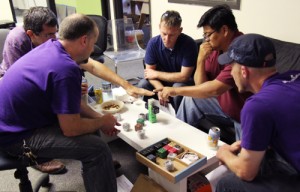
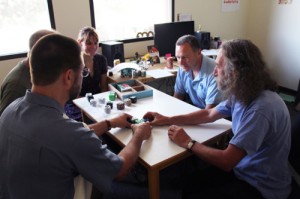 Did I tell you educators knew how to have fun?
We are privileged to be parts of the kinds of learning communities that deeply consider the role of building and making, coding vs. computational thinking, student-lead and discovery-based learning, and how to support authentic and lasting learning. I’ve shared these moments with our education friends in classes with their students as we excitedly watched what students created and discovered. I’ve had these moments meeting with our allies over coffee and beer. I’ve had this moment at events and conferences too, but I don’t want these moments just to be warm memories that sustain me at my desk. So, it seemed only fitting that we would take the next step and not just be members of that community, but hosts that help build and sustain it.
What emerged was grander even than that – a genuine desire, from everyone at the table, to be part of a movement changing what students learn, and how they learn it. My kind of party.
Did I tell you educators knew how to have fun?
We are privileged to be parts of the kinds of learning communities that deeply consider the role of building and making, coding vs. computational thinking, student-lead and discovery-based learning, and how to support authentic and lasting learning. I’ve shared these moments with our education friends in classes with their students as we excitedly watched what students created and discovered. I’ve had these moments meeting with our allies over coffee and beer. I’ve had this moment at events and conferences too, but I don’t want these moments just to be warm memories that sustain me at my desk. So, it seemed only fitting that we would take the next step and not just be members of that community, but hosts that help build and sustain it.
What emerged was grander even than that – a genuine desire, from everyone at the table, to be part of a movement changing what students learn, and how they learn it. My kind of party.
